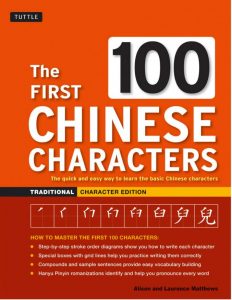• Lesson One:
Most of the characters in Lesson One (derived from the title of the Four Great Vows) do not have their own entries in Tuttle’s “First 100 Chinese Characters” or “Second 100 Chinese Characters“. However, all but four have relevant entries that can be useful for practice. All page numbers below are in the “First 100 Chinese Characters” except where specifically noted. References to the “Second 100 Chinese Characters” are only given when I couldn’t find anything in the “First 100” book.
These are the characters for Lesson One:
四, 囗, 儿, 弘, 弓, 厶, 折, 言, 扌, 手,
斤, 口, 原, 頁, 白, 小, 自, 八, 日, 目
• 四 is on page 13
• 囗 does not have its own entry, but is a component of: 國 (guó, country) on page 56, also see 日 (rì, day) below
• 儿 does not have a separate entry, but is a components of: 見 (jiàn, see) on page 54, and 兒 (ér, child) on page 75
• ** 弘 does not have any relevant entries (although both of its components, 弓 and 厶, do – see below)
• 弓 is a component of 弟 (dì, younger brother) on page 69
• 厶 is a component of 去 (qù, to go) in “Second 100” book on page 54
• ** 折 has no relevant entries (although both of its components, 扌 and 斤, do)
• 言 is a component of 請 (qǐng, please) on page 23, and also 課 (kè, lesson/class) on page 42
• 扌 is a component of two characters found in the “Second 100” book: 打 (dǎ, to hit) on page 33, and 找 (zhǎo, to search) on page 65
• ** 手 no relevant entries in either book (although the radical form, 扌, does)
• 斤 is a component of a character found in the “Second 100” book: 所 (suǒ, dwelling) on page 55.
• 口 is a component of 問 (wèn, ask) on page 24, and it also has its own entry in the “Second 100” book on page 94.
• ** 原 no relevant entries (but, again, its component parts do)
• 頁 is very similar to 貴 (guì, honorable) on page 25,
• 白 is a component of 的 (de, possessive particle) on page 62
• 小 is on page 48.
• 自 is a component of a very famous character found in the “Second 100” book: 道 (dào, The Way) on page 80.
• 八 is on page 17
• 日 is on page 98
• 目 is a component of a character in the “Second 100” book: 現 (xiàn, to appear) on page 15. See also 見 (jiàn, see) above.
.

